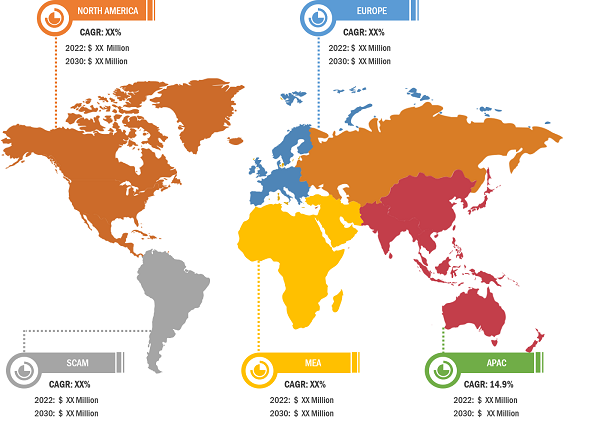According to our new research study on “Orthopedic Navigation System Market Size and Forecast to 2030 – Global and Regional Analysis – by Technology, Application, End User and Geography,” the market is expected to grow from US$ 2,532.47 million in 2022 to US$ 7,477.32 million by 2030; it is estimated to record a CAGR of 14.5% during 2022–2030. Key driving factors behind the market development are growing advantages of computer-assisted orthopedic surgeries and increasing incidence of orthopedic conditions. However, regulatory control, complexity, and high cost associated with orthopedic navigation systems hamper the market growth.
During surgery, orthopedic navigation technology guides the surgeon's movements and shows the position of each instrument and anatomical structure in real time by projecting the tools onto preoperative imaging data. It finds its applications in orthopedics. Real-time observations are made using an MRI, scanner, video camera, or other imaging techniques. Navigation data is integrated into the image to assist the surgeon in determining the exact place within the body of the patient. Before surgery, medical imaging is sometimes utilized to plan an operation. The system may compare the actual position of the target object to the ideal location determined during the planning phase, owing to data integration. Examples of such systems include mechanical, electromagnetic, or optical systems. Optical devices, passive or active, are the most frequently used. Cameras in the former system detect certain markers such as reflective targets, particular shapes, or colors.
Orthopedic Navigation Systems Market Size and Forecasts (2020 - 2030), Global and Regional Share, Trends, and Growth Opportunity Analysis Report Coverage: By Technology (Electromagnetic, Optical, and Others), Application (Knee, Hip, Spine, and Others), End User (Hospitals, Ambulatory Surgical Centers, and Others), and Geography (North America, Europe, Asia Pacific, Middle East & Africa, and South & Central America)
Orthopedic Navigation Systems Market Opportunities by 2030
Download Free Sample
The orthopedic navigation system market is segmented on the basis of technology, application, and end users. In terms of technology, the market is segmented into electromagnetic, optical, and others. The electromagnetic segment held the largest market share in 2022 and is anticipated to register the highest CAGR during 2022–2030. Electromagnetic (EMT) navigation systems are used widely in orthopedic surgeries. EMTs utilize fluoroscopy to screen the patient without using ionizing radiation, and it does not expose the patient to any energy fields that are more harmful than ultrasounds.
By application, the orthopedic navigation system market is segmented into knee, hip, spine, and others. The knee segment held the largest market share in 2022. The hip segment is anticipated to register the highest CAGR during 2022–2030.
In terms of end user, the orthopedic navigation system market is segmented into hospitals, ambulatory surgical centers (ASCs), and others.
Growing Organic and Inorganic Strategies by Key Market Players to Create Opportunities for Orthopedic Navigation System Market During Forecast Period
The technological developments in orthopedic navigation systems are rising constantly. Orthopedic procedures are becoming precise and accurate due to advances in image-guided navigation, robotic surgery, and real-time tracking. These tools help surgeons with precise implant positioning and alignment, improving surgical planning and reducing the risk of problems. Following are a few developments by the major market players:
- In April 2023, Ortho Development Corporation announced a distribution partnership with Naviswiss, a Switzerland-based technology company. The press release states that the collaboration combines Ortho Development's 29 years of clinical success in hip and knee arthroplasty with Naviswiss' innovative miniaturized hand navigation solutions. It also mentions that the partnership provides orthopedic surgeons across the US with a tool for improved accuracy, predictability, and documentation of results.
- In March 2023, Proprio launched its AI-powered surgical navigation system in operating rooms (OR) to collect data that will ultimately help surgeons improve the delivery of procedures. Proprio currently has a system focused on navigation during spinal procedures. It allows surgeons to digitally image and visualize the surgical site in the OR and then take the information outside the room for postoperative analysis. The system can monitor which implants are used, entire procedure length, and specific sections and look deeper into the body than a surgeon can see.
- In March 2023, Medtronic and First Imaging entered a strategic collaboration to provide advanced and accessible orthopedic treatments. The partnership included integrating Medtronic's orthopedic navigation system and First Imaging's mobile 3D C-arm. The integration provides operators with diverse and accessible equipment solutions and complements and enriches Medtronic's SURGICAL SYNERGY intelligent orthopedic integrated solutions.
- In December 2022, SeaSpine Holdings Corporation announced the deployment of 100th 7D FLASH navigation system across the world.
Orthopedic Navigation System Market: Competitive Landscape and Key Developments
B. Braun SE, Stryker Corporation, Medtronic PLC, Zimmer Biomet, DePuy Synthes, Smith & Nephew, Siemens Healthineers, Brainlab AG, Metronor, and Naviswiss AG are among the major players in the orthopedic navigation system market. These leading players adopt strategies such as the launch of new products, expansion and diversification of their market presence, and expansion of new customer base to tap prevailing business opportunities.
In June 2023, Brainlab AG collaborated with AO Foundation to extend reality technology for best practices in education and training. This collaboration will increase knowledge acquisition, enhance decision making and improve coordination of skills, all within a safe and engaging setting.
In May 2023, Brainlab AG collaborated with AI-driven TheraPanacea to enchance radiotherapy efficiency. The integration of AI-powered organ segmentation software from TheraPanacea, a medical technology company specializing in automatic, dependable, and quick tools for high precision radiotherapy, was announced by Brainlab, a digital medical technology company, at the European Society for Therapeutic Radiology and Oncology (ESTRO) annual meeting in Vienna. By collaborating with TheraPanacea, Brainlab users have more segmentation options for organs at risk (OAR), which enhances radiation therapy effectiveness.
Contact Us
Phone: +1-646-491-9876
Email Id: sales@theinsightpartners.com